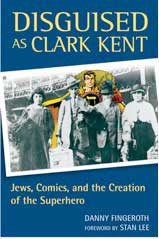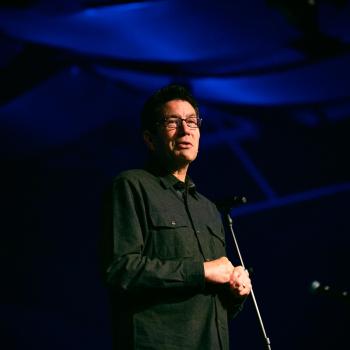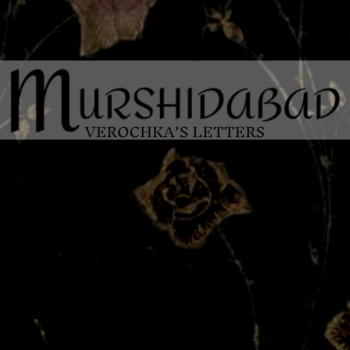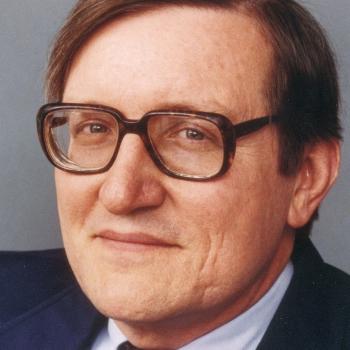 Much has been written recently on the prevalence of Jews in early comic book production, both as writers and artists, and as publishers, owners, and managers. Depression-era Jews found work in the industry because comic books were generally despised, and immigrants and their children often find employment doing the work no one else wants to do.
Much has been written recently on the prevalence of Jews in early comic book production, both as writers and artists, and as publishers, owners, and managers. Depression-era Jews found work in the industry because comic books were generally despised, and immigrants and their children often find employment doing the work no one else wants to do.
A recent entry to the corpus, Danny Fingeroth's Disguised As Clark Kent: Jews, Comics, and the Creation of the Superhero (Continuum, 2007) ponders this reality through the twin lenses of comics expertise and Jewish culture. The author of the much-admired Superman on the Couch (Continuum, 2004), Fingeroth is a former editorial director of the Spider-Man comics and the current Senior Vice-President of Education for the Museum of Comics and Cartoon Art in New York. Fingeroth is also, as Spider-Man's creator Stan Lee notes in his forward, the son of a cantor.
That personal detail provided by Lee helps explain the eloquent affection and empathy with which Fingeroth writes about the creators of our most beloved and iconic superheroes, such as Superman's Jerry Siegel and Joe Shuster, Captain America's Jack Kirby and Joe Simon, Batman's Bob Kane, MAD Magazine's Harvey Kurtzman, and The Spirit's Will Eisner. Fingeroth writes about these children of the shtetl as though he spent his childhood evenings sitting with them at the supper table, listening enthralled to their stories. And perhaps, in a sense, he did.
As a result, the book is personal, touching, and pleasurable to read. Fingeroth elegantly dispenses with the thorny problem of author intent, maintaining that the comics' creators never intended to create specifically Jewish heroes or tell specifically Jewish stories. Lee helps him by writing in his forward that "we never thought about it, never talked about it, never even seemed to be aware of it." In Fingeroth's view it doesn't matter that these creators, sharing an Eastern European Jewish heritage, were not overly conscious of their identity. Indeed, it might be one stamp of their Jewishness that their heroes and their stories have universal appeal.
Fingeroth proceeds by sketching short biographies of these legendary comics creators, and then discussing the ways in which the superheroes and their stories reflect the culture, history, traditions, habits, and morality of Eastern European Jewish immigrants. This is a liberating hermeneutic that allows Fingeroth to compose some of his most enticing prose.
He is at his inspiring best when he is engrossed in discovering the ultimate meaning of these heroes. His discussion of Superman is a wonderful example. He identifies Moses and Jesus as "the main metaphor systems at war for credit for the inspiration of Superman." Is Superman a Jesus figure (an argument recently disputed in this column), or is Superman a Moses figure, as many others have contended?
While Fingeroth finds more merit in the Moses metaphor than in the Jesus one, he also points out that both metaphors are limited. Still, his close reading of these somewhat simplistic alternatives leads to a much more nuanced reading of the saga, one that uncovers many rich strains of cultural significance.
The story of Superman's Kryptonian parents, for example, is to Fingeroth a powerful metaphor for the sacrifices that immigrant parents make so that their children can prosper. In addition, Superman's story is "the inspired marriage of the myth of the pioneer and the myth of the immigrant," so that his combined loneliness and strength embody the immigrant experience, the experience of leaving the familiar and trailblazing in a new world. Add to this the stature that Superman earns in his adopted homeland, a potent reminder that in the United States, "no matter where you are from or who your parents are, you can be accepted and appreciated and can make a difference."
This method of freely speculative close readings of the superheroes' stories unfettered by concerns of author intent is refreshing. Fingeroth applies it to many of the other classic comics icons, including Thor, the X-Men, Captain America, and Spider-Man, and in this way uncovers and reveals countless fascinating tropes and themes that have driven these stories and given them resonance and meaning worthy of their iconic status. This book will be invaluable to all would-be writers, working in any medium.
The problem is that while Fingeroth effectively dispenses with the intentions of the creators, the creator's identity as a Jew becomes decisive. This converts the book into an unfinished theoretical work with several unsatisfying consequences. Fingeroth acknowledges problems with essentialism (the view that for any specific kind of thing, in this case a Jew, there is a set of characteristics which all Jews must possess), yet he does little to avoid it. This leads to some really unfortunate stereotyping at times, as when Fingeroth argues that the Fantastic Four's bickering is an example of their Jewishness.





